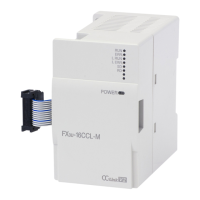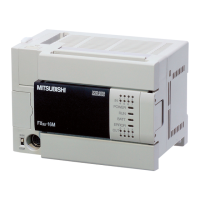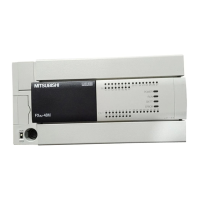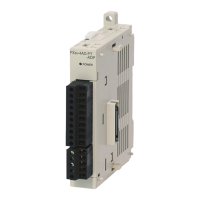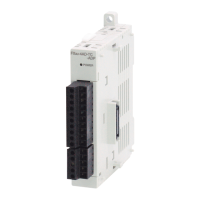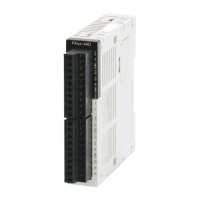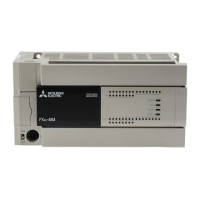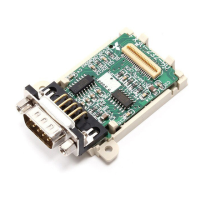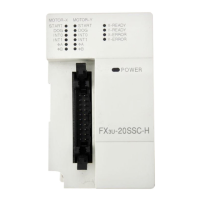FX3U Series Programmable Controllers
User’s Manual - Hardware Edition
219
11 Use of High-speed Counters (C235 to C255)
11.9 Calculation of Response Frequency and Overall Frequency
11
High-Speed
Counters
12
Output Wiring
13
Wiring for
Various Uses
14
Test Run,
Maintenance,
Troubleshooting
15
IInput/Output
Powered
Extension Units
16
Input/Output
Extension
Blocks
17
Extension
Power Supply
Unit
18
Other Extension
Units and
Options
19
Display Module
20
Terminal Block
1) Calculation of overall frequency
The overall frequency is calculated by the high-speed comparison instruction used in the program based
on the above table.
Overall frequency ≥ Sum of "response frequency of high-speed counter × Magnification for
calculation of overall frequency"
2) Example of calculation
When only HSZ instruction is used six times in a program, the frequency is calculated by the formulas
shown in the "Only HSZ instruction" column in the above table.
2. When FX3U Series special function units/blocks and analog special adapters are used
*1. When an index register is added to a counter number specified by HSCS, HSCR, HSZ or HSCT
instruction, all hardware counters are switched to software counters.
*2. The high-speed counters C244(OP) and C245(OP) cannot count signals of 10 kHz or more.
High-speed counter No. to be
used
Input
frequency
Calculation of max.
response frequency
Magnification
for
calculation of
overall
frequency
Instruction
to be used
C237
Operation as
software counter
30kHz 40 - 6(times) = 34kHz
×1
HSZ instruc-
tion is used
six times.
C241
Software counter
20kHz 40 - 6(times) = 34kHz
×1
C253(OP)
[4 edge count]
4kHz {40 - 6(times)} / 4 = 8.5kHz
×4
Counter type
Counter
Nos.
Software
counters
with
HSCS,
HSCR,
HSZ or
HSCT
instructio
n *1
Magni-
fication
for
calcu-
lation
of
overall
frequ-
ency
Response frequency and overall frequency depending on
conditions of instruction to be used
Neither HSZ nor
HSCT instruction
Only HSCT
instruction
Only HSZ instruction
Both HSZ and HSCT
instructions
Max.
response
frequency
(kHz)
Overall
frequency
(kHz)
Max.
response
frequency
(kHz)
Overall
frequency
(kHz)
Max.
response
frequency
(kHz)
Overall
frequency
(kHz)
Max.
response
frequency
(kHz)
Overall
frequency
(kHz)
1-phase
1-count input
C241,
C242,
C243,
C244,
C245
C235,
C236,
C237,
C238,
C239,
C240
×1
30
60
25
50
30 -
(number of
instruc-
tions)
*2
50 - 1.5
×
(number of
instruc-
tions)
25 -
(number of
instruc-
tions)
*2
50 - 1.5
×
(number of
instruc-
tions)
−
C244(OP),
C245(OP)
×1
10 10
1-phase
2-count input
C247,
C248,
C249,
C250
C246,
C248(OP)
×1
30 25
2-
phase
2-
count
input
1 edge
count
C252,
C253
(OP),
C254,
C255
C251,
C253
×1
30 25
4 edge
count
×4
7.5 6.2
(30 -
number of
instruc-
tions) / 4
(25 -
number of
instruc-
tions) / 4
1) The overall frequency is calculated as shown below because HSZ instruction is
used six times.
Overall frequency = 80 - 1.5
×
6 = 71kHz
2) The sum of the response frequencies of the high-speed counters used is
calculated as shown below.
"30kHz
×
1[C237]" + "20kHz
×
1[C241]" + "4kHz
×
4[C253(OP)]" = 66kHz
≤
71kHz
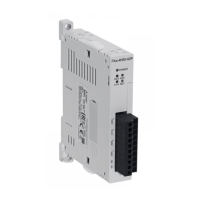
